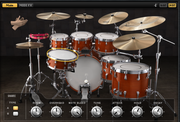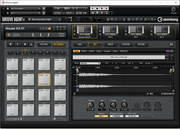First, be aware that Groove Agent SE is much more limited in the scope of what can be edited and how than the full blown, retail, system/daw portable version of Groove Agent 5. The SE version can only load one kit per instance, where the full version can have up to 4 kits per instance.
Even if you have the full version, some kits are locked down so that editing is limited to working through special macro screens, and pads are often locked so that individual kit pads cannot be added or changed. While one can load multiple kits and do some pad trigger remapping to emulate simply making a single kit ‘bigger’, it’s usually much easier to just use separate tracks for each kit, and unless you need the score editor in Cubase, there’s no major advantage to trying to merge it all into a single track.
Some kits are locked down and cannot be modified. Typically these will be kits with with the fancy macro screen showing a picture of the kit that dances around while playing the instrument (Instrument/Edit tab), has a lot of pre-built mixing macros, and may even come with pattern ‘style builder’ templates.


With kits like this, the pads might be locked so that you cannot drag your own samples onto them. Other editors might be locked or have limits as to what a user can edit as well. Of course if you really need it, GA itself can remap the pads to different triggering events, but the pads themselves are simply locked from being edited. Why are they locked? Well, such kits have a lot of custom scripting going on inside. It would be rather easy for a user to break the whole kit by dragging things around. It can also be a form of copy-protection for Groove Agent content developers.
Agent kits like this are carefully constructed to act like a full kit, played by the same individual, with the same sticks, in the same room, all under the same set(s) of mics, etc…so think of it more like, “I’ve got a drummer in a room with all his stuff.” If you need things that he doesn’t have with him today, then call up another drummer (instance), and have him set up his junk in another room. “Yo Paul, Gene forgot to bring his shakers and a triangle, and we really need those. Can you drop by for a session today and bring those toys with you?”
Some kits are fully unlocked. These usually use the built in Groove Agent UI for editing things, and do NOT have custom UI macros under the ‘Instrument/EDIT’ tab. With kits like this, you’ll find that one can drag and drop samples right onto a pad, and quite a few editing tabs will be available for define how the pad should work, establishing the mix/routing, applying effects, and more.

It’s fine to use multiple instances on separate tracks. Personally, I’d just put the related tracks into the same folder in the Cubase Project and leave it that way. Cubase makes it pretty easy to edit (piano roll, diamond drum, list, or in place track editors) more than one track/part/event from the project view at a time. If you keep each lane as an ‘instrument track’, and are into the MIDIloop thing, then yes, you can have multiple tracks saved into a single MIDIloop file. Simply select all the instrument tracks you want saved in the loop first, then save/name your loop. At that point it can be instantly auditioned in your media bay without having to manually set up instruments and all.
If you really ‘need’ things to be from a single track, I.E. To use the score editor, and have everything on the same drum stave, assigned to a line/space/shape, etc…then have a look at this thread,
There is an XML hack you might try to convince a Cubase Drum Map (assigned or created from a pop up in the track inspector of project view) to point to different instrument end points (such as more than one instance of Groove Agent) from a single track.